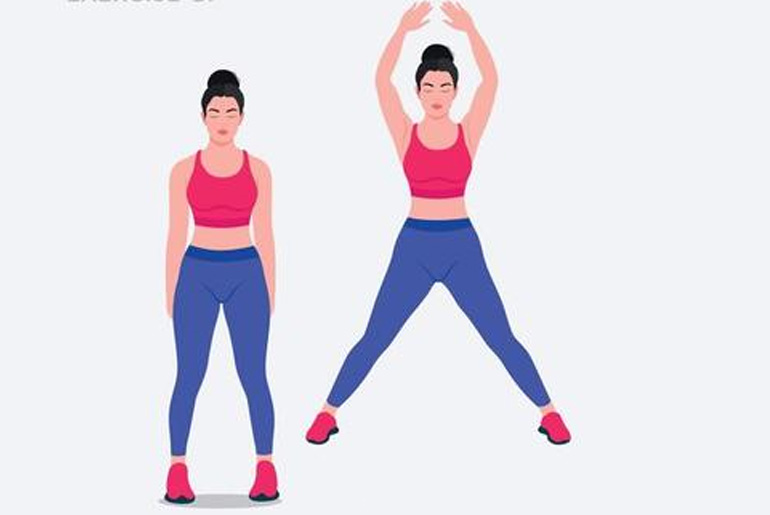Jumping jacks, a fun and engaging full-body exercise, are not just for kids—they are a great cardio workout that involves multiple muscle groups. Unlike exercises that focus on specific areas, jumping jacks engage the entire body, helping to increase heart rate and burn calories. Since excess belly fat can lead to health issues, many people look for effective ways to reduce it. While jumping jacks contribute to overall fat loss, they do not directly target belly fat. Spot reduction is a myth, but incorporating jumping jacks into a well-rounded fitness routine with strength training and a balanced diet can help achieve a flatter tummy over time.
Jumping Jacks: A Full-Body Cardio Exercise
Jumping jacks are an engaging and fun exercise that effectively targets multiple muscle groups, making them an excellent cardio workout. This simple movement involves jumping, spreading your legs, and raising your arms overhead before returning to the starting position. The movement increases heart rate, burns calories, and engages muscles like the quadriceps, abdominals, and shoulders.
Do Jumping Jacks Burn Belly Fat?
While jumping jacks contribute to overall fat loss, they do not directly target belly fat. The idea of “spot reduction,” where one targets fat loss in a specific area of the body, is a myth. Fat loss occurs across the entire body when you engage in regular physical activity, including high-intensity exercises like jumping jacks.
Jumping jacks, as part of a well-rounded fitness routine, help burn calories and contribute to the reduction of visceral fat (the harmful belly fat associated with conditions like type 2 diabetes and heart disease). However, fat loss will happen gradually throughout the body, not just in the belly area. To specifically target belly fat, it’s essential to combine jumping jacks with a healthy, balanced diet, other forms of aerobic exercises (like running or swimming), and strength training.
How to Perform Jumping Jacks Correctly
For optimal results, jumping jacks should be performed with proper form and consistency:
- Starting Position: Stand with your feet together and arms at your sides.
- Jumping Movement: Jump up, spreading your legs shoulder-width apart while raising your arms overhead.
- Return to Start: Jump again to bring your feet back together and lower your arms to your sides.
- Repeat: Continue the movement at a steady pace.
Tips for Beginners and Progression
- Start Slowly: Beginners can start with 3 sets of 20 to 30 reps and gradually increase the repetitions as they build endurance and strength.
- Consistency: Perform jumping jacks 3 to 5 times a week for optimal benefits.
- Warm-Up: Always warm up before doing jumping jacks to prepare your muscles and joints, lowering the risk of injury.
- Engage Your Core: Make sure your core is activated throughout the exercise to maximize its effectiveness and support your back.
Common Mistakes to Avoid
- Landing Too Hard: Avoid landing with heavy impact on your knees and ankles. Always aim to land softly.
- Not Engaging the Core: Failing to engage your core can decrease the effectiveness of the exercise and may strain your back.
- Skipping Warm-Up: Not warming up before jumping jacks increases the risk of injury.
- Slouching Posture: Ensure that your posture is straight with your spine aligned. Keep your shoulders relaxed.
Do Jumping Jacks Only Burn Belly Fat?
Jumping jacks do not specifically burn belly fat. Instead, they promote overall fat loss, which includes reducing belly fat. Besides helping with fat loss, jumping jacks have various health benefits:
- Cardiovascular Health: They strengthen the heart, improve circulation, and can help lower blood pressure, reducing the risk of heart disease.
- Muscle Endurance: They engage multiple muscle groups (legs, arms, core) and help improve muscle endurance and overall strength.
- Coordination and Balance: The synchronized movement of arms and legs helps improve coordination and balance over time.
Are Jumping Jacks Suitable for Everyone?
While jumping jacks are effective, they are not suitable for everyone due to their high-impact nature. The repeated jumping motion can put significant pressure on the joints, making them less ideal for certain individuals, including:
- People with Joint Pain or Injuries: Those with knee, ankle, or hip issues should be cautious, as the impact can worsen their condition.
- Pregnant Women: Pregnant women may experience joint instability due to hormonal changes (like relaxin), increasing the risk of falls or injuries.
- Individuals with Heart Disease or High Blood Pressure: Jumping jacks elevate heart rate rapidly, which may lead to dizziness or breathlessness for those with cardiovascular issues.
- People with Osteoporosis: Those with osteoporosis should avoid high-impact exercises to prevent fractures.
It’s always advisable to consult a doctor before starting a new workout routine, especially if you have any health concerns or conditions.
Jumping jacks are a fun and effective exercise for overall fat loss, including belly fat, but they cannot specifically target belly fat. To achieve a flatter tummy, it’s essential to combine jumping jacks with a balanced diet, other forms of aerobic exercises, and strength training. Additionally, proper form, consistency, and safety precautions are key to maximizing the benefits of jumping jacks while minimizing the risk of injury.
Disclaimer:
The information contained in this article is for educational and informational purposes only and is not intended as a health advice. We would ask you to consult a qualified professional or medical expert to gain additional knowledge before you choose to consume any product or perform any exercise.







